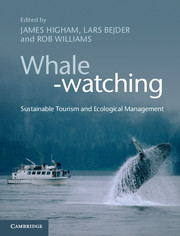Book contents
- Frontmatter
- Dedication
- Contents
- Acknowledgements
- List of contributors
- List of abbreviations
- 1 Tourism, cetaceans and sustainable development
- Part I The historical and contemporary contexts
- 2 Threats facing cetacean populations
- 3 From exploitation to adoration
- 4 Human attitudes and values
- 5 The whale-watching industry
- 6 The International Whaling Commission (IWC) and whale-watching
- Part II Human dimensions of whale-watching
- Part III Ecological dimensions of whale-watching
- Part IV Sustainable management: insights and issues
- Index
- Plate Section
- References
3 - From exploitation to adoration
The historical and contemporary contexts of human–cetacean interactions
from Part I - The historical and contemporary contexts
Published online by Cambridge University Press: 05 April 2014
- Frontmatter
- Dedication
- Contents
- Acknowledgements
- List of contributors
- List of abbreviations
- 1 Tourism, cetaceans and sustainable development
- Part I The historical and contemporary contexts
- 2 Threats facing cetacean populations
- 3 From exploitation to adoration
- 4 Human attitudes and values
- 5 The whale-watching industry
- 6 The International Whaling Commission (IWC) and whale-watching
- Part II Human dimensions of whale-watching
- Part III Ecological dimensions of whale-watching
- Part IV Sustainable management: insights and issues
- Index
- Plate Section
- References
Summary
Introduction
Cetaceans have long held great significance in the lives of humans. This significance has been both practical and spiritual and is reflected in artefacts dating back some 10,000 years, in spoken myths and legends, in the writings of Greek and Roman philosophers and many more recent chroniclers of the encounters between humans and wildlife (Alpers, 1963; Cousteau & Diolé, 1972; Constantine, 2002; Neimi, 2010). Some cultures have feared cetaceans, others have been indifferent, while still others revered them, erecting statues and totems in their honour and even deifying them in some cases (Constantine, 2002). Broadly speaking, the historical view of cetaceans was divided along loose phyletic lines: dolphins being seen as sleek, graceful and a good omen for sailors (or simply as pests to fishers), while the great whales were monstrous, mysterious and fearful.
With increasingly thorough exploration and exploitation of riverine and oceanic habitats over the course of the last few centuries, human–cetacean interactions have moved far beyond opportunistic encounters and come to span the broadest possible spectrum (Whitehead et al., 2000). Humans and cetaceans have engaged in commensal and mutually beneficial foraging relationships; humans have hunted cetaceans for food, bait, oil, baleen and other resources, culled cetaceans over fears of competition for fish resources, and captured them for display in aquaria; and cetaceans have, in turn, exploited various human activities for assisted locomotion, play and the procurement of food (e.g. Busnel, 1973; Shane et al., 1986; van Waerebeek & Reyes, 1994; Orams, 1997; Samuels & Tyack, 2000; Read, 2008). This spectrum of interactions has resulted in negative, neutral and positive outcomes for both humans and cetaceans involved.
- Type
- Chapter
- Information
- Whale-watchingSustainable Tourism and Ecological Management, pp. 31 - 47Publisher: Cambridge University PressPrint publication year: 2014
References
- 9
- Cited by

